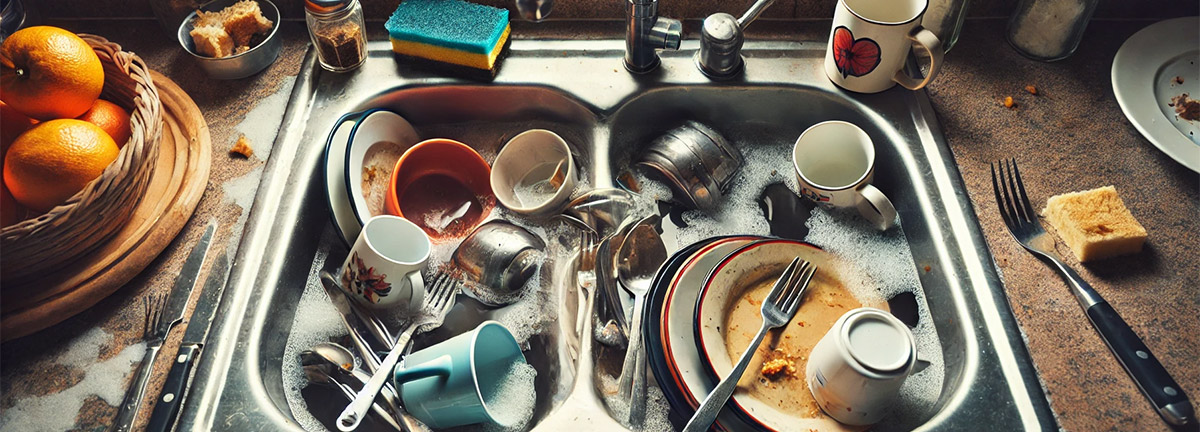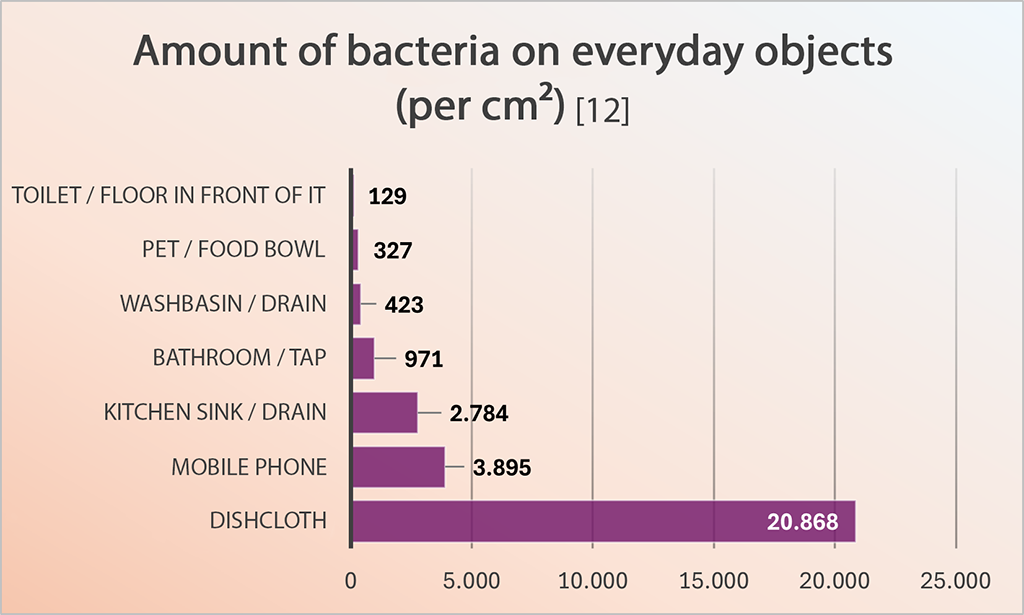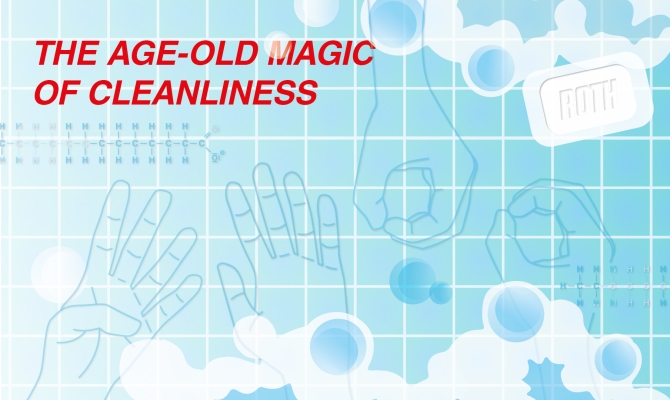
How much does hygiene help against germs?
A superficial look at germs: from disinfection to probiotics
Humans make up only 0.01 percent of the planet’s total biomass. Bacteria, on the other hand, make up 13 percent of the biomass and are clearly superior to us in this respect. This blog post explains how microorganisms colonize surfaces, what we should and shouldn’t do about it, and where the biggest germ hotspots lurk at home.
Wherever you look, there they are: bacteria. Prokaryotes, which are only micrometers in size, can be found almost everywhere. A thousand in a cubic metre of air, millions in a teaspoon of seawater, billions in a cubic centimetre of earth. [1] And although the majority of bacteria are harmless or even indispensable for humans, there is still a great deal of concern about germs – and in some cases it is justified. After all, pathogens that can harm humans are in a constant arms race with the pharmaceutical industry and the manufacturers of disinfectants. It is a battle that is primarily fought on surfaces – where bacteria settle and survive until the next finger picks them up and provides them with a new culture medium. [1]
Biofilms – the protective shield of microbes
To colonise surfaces, many types of bacteria have developed a type of protective mechanism that significantly improves their chances of survival. This is known as a biofilm. “Biofilms are communities of bacteria, for example, that attach themselves to surfaces and grow there. A characteristic feature is that the cells are surrounded by a microbially induced matrix – the extracellular polymeric substance EPS. They offer the population protection from chemical and physical environmental influences such as disinfectant solutions, biocides, antibiotics or radiation”. This partial definition from the website of the Fraunhofer Institute for Interfacial Engineering and Biotechnology (IGB) gives an idea of how important it can be to prevent biofilms from forming in the first place. [2]
Certain conditions apply to the colonization of a surface. Firstly, the pathogen must come into contact with the surface. When the first free-swimming planktonic cells attach to a surface, this is still a highly reversible process in which weak Van der Waals interactions play a major role. If the conditions on the surface are conducive – including material properties but also environmental conditions such as water content, temperature or flow conditions – the first monolayers and microcolonies form through cell division. The microbes form an initial bond to the surface with the help of special molecules called adhesins. This process is only partially reversible. By the next step at the latest, when the bacterial community produces a slime of polysaccharides, the colony becomes irreversibly adhered to the surface. Then, according to the Fraunhofer IGB, even “vigorous rinsing no longer helps” to remove the microbes. [3]
Adhesins are special molecules that enable cell-cell adhesion or help cells to adhere to substrates. Such adhesion processes are important for the formation and maintenance of tissues, for example, but are also relevant for the immune system. Lymphocytes, for example, adhere to certain tissues in the body, but pathogens also use adhesins to attach themselves to the host’s epithelial cells and trigger an infection. In chemical terms, bacterial adhesins include glycoproteins, proteins or glycolipids on the cell surface. [4]
It is therefore crucial to prevent biofilm formation at a very early stage, for example by applying an appropriate antimicrobial finish to the surface. IGB is researching various coatings into which biocides or naturally antimicrobial substances can be incorporated. Photocatalytically active surfaces can also have an antimicrobial effect. But even a simple coating of copper can prove useful in protecting against pathogens.
Unattractive surfaces for germs
The Medical University of South Carolina (MUSC) tested the impact of copper-coated door handles on hospital hygiene. The results showed that the risk of infection fell by 40 percent when patients were in rooms whose door handles, switches, etc. were coated with copper. [5] The antibacterial effect of copper is based on the fact that it releases cations into the environment through corrosion, which damage bacteria and prevent their growth or kill them completely. [6] The copper ions first attack the cell wall of the bacteria and damage the cell membrane. The microbes need copper ions to survive and have special ion channels in their membrane to absorb them from the environment. However, the high concentration of ions on a copper surface causes veritable flooding of the cell interior, which catalyses toxic reactions and leads to the degradation of bacterial DNA. The cytoplasm finally leaks out through the damaged membrane and the bacterium is killed. [7]
It is essential – especially in hospitals – to keep pathogens at bay. On the one hand, many patients have a weakened or severely compromised immune system and, on the other hand, germs are introduced in large numbers by the sick person and can multiply and spread if hygiene is inadequate. According to estimates by the Robert Koch Institute, 10,000 to 20,000 people die every year in Germany from nosocomial infections, i.e. from hospital-acquired pathogens, including multi-resistant strains. [8]
Alternative cleaning: More microbes rather than stronger disinfection
The effort required for hygiene measures in the clinical environment is correspondingly high. Regular cleaning and thorough disinfection are aimed at keeping the number of germs in the hospital low. However, some experts question whether disinfection is the only or even the best way to achieve a low-infection environment. In a study conducted by Charité Berlin and Jena University Hospital in 2021, scientists demonstrated that the floor of a room is recolonized with microbes just half an hour after disinfection – including multi-resistant pathogens. In a follow-up study, the researchers then compared classic disinfection measures with the use of a probiotic cleaner. This led to a significantly lower occurrence of resistance genes after cleaning and, according to the researchers, could constitute a proven alternative to traditional disinfection. The cleaner supports the development of a harmless microbial community on the surface, which makes it more difficult for dangerous pathogens to spread there, as space and available nutrients are already taken up. [9,10] A strategy that many people could also remember for their own household use.
“It would be more hygienic to eat from the toilet than from the sink drain valve.”
Dr. Philip M. Tierno, Director of Microbiology & Immunology at New York University, in an interview with National Geographic [11]
In fact, the toilet is comparatively sparsely colonized with bacteria. The undisputed leader in the household is the dishcloth. [12]

Humans as part of the microbial community
Just like in hospitals, improper or excessive use of disinfectants in your own bathroom and kitchen can do more harm than good. For example, the Federal Ministry of Health advises against using products with an antimicrobial effect at home. According to the BMG, the disinfectant effect of such household cleaners has not always been proven. If cleaning agents with reduced effectiveness are used regularly or if disinfectants are used improperly, microorganisms can even become insensitive to the active ingredients. Disinfectant cleaning agents are also harmful to the environment and pose a health risk. [13]
With the exception of immunocompromised people or in times of acute infection such as the coronavirus pandemic, people generally cope well with typical household germs, meaning that disinfection is not usually necessary. Because one thing is clear: a germ-free environment would neither be healthy for us, nor even feasible. Simply because we ourselves release numerous microorganisms into our environment at any given moment, through our skin and the air we breathe. Ultimately, humans are just another surface for microbes to colonize. [11]
Sources:
[4] https://www.spektrum.de/lexikon/biologie/adhaesine/1054
[7] https://copperpen.ch/pdf/solioz11a.pdf
[8] https://www.rki.de/SharedDocs/FAQ/Krankenhausinfektionen-und-Antibiotikaresistenz/FAQ_Liste.html
[9] https://www.mdr.de/wissen/mikroben-putzen-statt-desinfektion-100.html
[10] https://www.clinicalmicrobiologyandinfection.com/article/S1198-743X(22)00109-4/fulltext
[11] https://www.nationalgeographic.de/wissenschaft/2018/04/das-paradies-fuer-keime
[12] https://dock.centroplast.de/de/download/show/centroplast_broschuere_fl_centroguard_de.pdf


